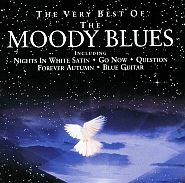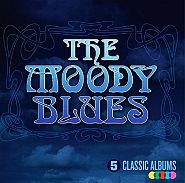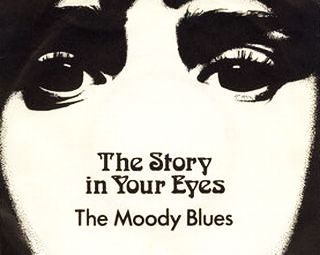
Portion of the French single sleeve for Moody Blues’ 1971 hit song, 'The Story in Your Eyes.' Click for Amazon digital single.
Music Player
“The Story in Your Eyes”-1971
The Moody Blues by 1971 were already a well known rock band with several hit songs and at least a half dozen albums to their credit. In addition to Hayward, as of 1971 the group also included John Lodge, Ray Thomas, Mike Pinder, and Graeme Edge.
Since their founding in the mid-1960s, the Moodies have sold at least 60 million albums worldwide, a number that is likely to rise once accounting discrepancies from earlier years are cleared up. “The Story In Your Eyes” is one example of their music at about mid-career, as they still had another three decades of recording and performing ahead of them. “The Story in Your Eyes” also appeared simultaneously on the Moodies’ August 1971 album, Every Good Boy Deserves Favour, and is regarded as the album’s best song by many critics.
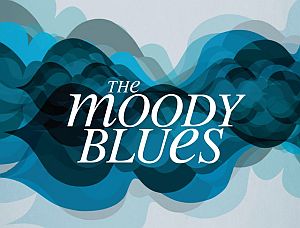
The Moody Blues, a popular British band with a worldwide following, have sold millions of albums globally.
At its release in 1971, “The Story in Your Eyes” rose on the Billboard pop chart to No. 23 in September, remaining in the Top 40 for about seven weeks. In the U.K, the album, Every Good Boy Deserves Favour, rose to No. 1. In the U.S., the album rose to No. 2 on the Billboard album chart, staying there for about four weeks.
Justin Hayward, in addition to writing the lyrics for “The Story in Your Eyes,” also sings its lead vocals. The song uses electric guitar primarily and also the mellotron, a favorite Moody Blues instrument of the 1960s, which gives the song a slightly orchestral sound. The mellotron is a keyboard instrument capable of duplicating the sound of violins, flutes, choirs, and it became something of a trademark sound on Moody Blues music of the 1960s and 1970s.
The Moodies’ music of this era, in fact, is sometimes described as “orchestral rock.” By their next album, Seventh Sojourn of 1972, the mellotron would be augmented by a similar instrument, the chamberlin, and in later years, both would be replaced by modern synthesizers.
|
“Story In Your Eyes” I’ve been thinking about our fortune And the sounds we make together Listen to the tide slowly turning But I’m frightened for your children Listen to the tide slowly turning But I’m frightened for the children When the final line is over |
The Song
“The Story in Your Eyes” is probably one of the more well-known songs by the Moody Blues, after their more famous earlier hits of 1967-68, “Nights In White Satin” and “Tuesday Afternoon.” But some Moodies fans look beyond these popularly-known works and point to other later hits as well, including “The Voice” (1981) and “Your Wildest Dreams” (1986) as equally good examples of the Moody Blues’ talents. Still, “Story” has its fans, on several levels.
One internet writer to SongFacts.com, for example — David of Syracuse, NY — voiced agreement with earlier Song Facts writers who liked the song, but noted it held special meaning and memories for him, as he described:
“…This song is so great, and timeless… I had this album when I was 17 in Syracuse… And then proceeded to buy every album that they created. These Moody Blues were one great band. I saw them in concert in March 1972. Syracuse War Memorial. The first concert I ever saw. And I remember it so well. The crowd was so cool, and well behaved….”
Another writer to SongFacts — Lisa, from Toronto, Ontario — explained that “Story” was one of her “top 10 songs of all time.” She suggested the song was about “a love that can withstand the tests of time — you have been through it all and nothing and no one can come between a love like that.”
Another interpretation of the song came from “abcbraveheart,” who offered comments at You Tube after viewing a Moody Blues video of the song:
“This is a song about End of Times,” he wrote. “[The singer] says there’s a chance that we can overcome the dark forces underpinning this life, but he seems certain that ‘The curtain is going to fall.’ We’ll see how it plays out? Great song.”
Planet’s Fate
The Moody Blues, in previous albums, had offered as part of their ongoing “message-in-the-music” style, concern for the fate of the planet. And some of that appears to be present in these lyrics as well — but not with an optimistic outcome. Here, they appear to be concluding, more or less, that things look pretty bleak, as in the lines: “the sunshine we’ve been waiting for will turn to rain” and, “I’m frightened for the children.” Perhaps all we have — the Moodies seem to be suggesting — is each other, and if we’re lucky, the safe harbor of a love relationship, as in the final line: “I can hide inside your sweet, sweet love for ever more.”
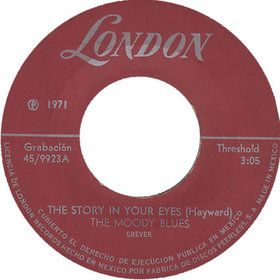
"The Story in Your Eyes" 45 rpm on the London / Threshold label, Mexican pressing, 1971.
All Music’s Planer, also noting that “The Story in Your Eyes” became one of the Moodies’ signature concert tunes, recommends the version recorded in 1993 on A Night at Red Rocks with the Colorado Symphony Orchestra, calling that version better than the original “in terms of sheer sonic force.”
The Moody Blues, of course, were quite successful well before the release of “The Story In Your Eyes” in 1971. The group was founded in Birmingham, England in May of 1964. Among their more famous hits prior to 1971, for example, are the following: “Go Now” of 1964; “Nights In White Satin” of 1967; “Tuesday Afternoon,” “Voices in the Sky” and “Ride My See-Saw,” all in 1968; “Never Comes the Day” in 1969; and “Question” in 1970.
Other hits would follow in the late 1970s, 1980s and beyond. The group also had a series of successful albums prior to 1971, including: Days of Future Passed (1967), In Search of the Lost Chord (1968), To Our Children’s Children’s Children (1969) On the Threshold of a Dream (1969) and A Question of Balance (1970) — all of which went gold, selling 1 million copies or more.
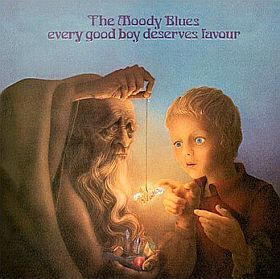
In the summer & fall of 1971, the Moody Blues album, “Every Good Boy Deserves Favour,” rose to No. 1 and No. 2 respectively in the U.K. and the U.S. It was also a million-seller. Click for Amazon.
By the late 1970s, they regrouped and returned to their music, enjoying a bit of a resurgence in the mid- and late-1980s with more popular hits and albums (see sources below for more details on these). The Moodies are definitely one of those bands that have gone through several phases in their musical career, though generally weathering the changes for the better with continued good music.
In recent years, they have toured the U.S., Canada and the UK, including tours in the years 2006 thru 2009. They have also issued remastered versions of most of their earlier albums plus prior never-released material.
For over four decades, the Moody Blues music has enjoyed a loyal following, making them one of the top-grossing bands in album sales and concert touring.
For more on the Moody Blues at this website, see, for example: “The Moody Blues: Breakout Music, 1967-1972,” covering their trend-setting “orchestral rock” album, Days of Futures Passed (1967) and other hits through the 1970s; and, “Legend of a Mind: Timothy Leary & LSD,” which uses the 1968 Moody Blues song as story title and intro to explore the song’s history and Leary’s role in the 1960s as an LSD/counter-culture proponent. Other stories on music history are found at the “Annals of Music” category page. Thanks for visiting – and if you like what you find here, please make a donation to help support the research and writing at this website. Thank you. – Jack Doyle
|
Please Support Thank You |
_________________________________
Date Posted: 8 February 2010
Last Update: 8 August 2023
Comments to: jackdoyle47@gmail.com
Article Citation:
Jack Doyle, “Story in Your Eyes, 1971,”
PopHistoryDig.com, February 8, 2010.
_________________________________
The Moody Blues at Amazon.com…
Sources, Links & Additional Information
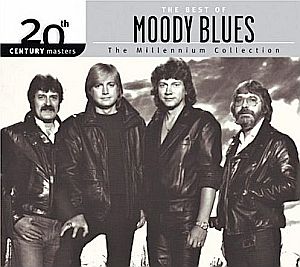
Members of the Moody Blues shown on the CD cover of a “Best of Moody Blues” collection in the 20th Century Masters series, issued by Polydor, March 2000. Click for Amazon.
Bruce Eder, “Biography, Moody Blues,” AllMusic .com, 2009.
“Moody Blues,” Wikipedia.org.
“Story in Your Eyes,” Wikipedia.org
Nancy Erlich, “Moody Blues Review,” New York Times, Arts & Leisure, Sunday, October 3, 1971, p.D-30.
Daniel Marks.” Dualities,” New York Times, Arts & Leisure, ( Letter re: Nancy Erlich’s review of The Moody Blues’ “Every Good Boy Deserves Favour”), Sunday, November 14, 1971, p. D-16.
“The Story In Your Eyes, The Moody Blues,” SongFacts.com.
Lindsay Planer, Song Review, “The Story In Your Eyes, Moody Blues,” AllMusic.com, viewed, January 21, 2010.
Moody Blues website with extensive collection of material.
Moody Blues website.
_______________________
